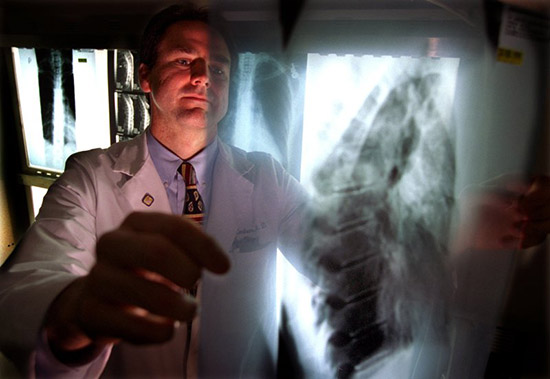精准医疗已经改变了癌症治疗,它将如何应用在其它领域?

|
21世纪是生物学的世纪,科学界和医学界都取得了巨大进步,改善了人们的生活质量。我们已经在肿瘤学看到了这种改善:得益于新疗法的发现,某些癌症已不再像以前一样相当于一纸死亡判决书了,它们在很大程度上已经相当于可以通过药物控制的慢性疾病。 精准医疗就是其中一种新疗法。这种新兴的疾病预防方法会将个体的遗传特性、所处环境和生活方式考虑在内,医生和研究人员因而可以更准确地预判哪种治疗方法最适用于这个人的这种疾病。 虽然抗癌斗争远未结束,但我们相信,精准医疗模式已经开始为其它疾病领域进行更有针对性的研究指明了方向。凭借我们在癌症精准医疗研究中获取的知识、管理经验和有效工具,其它疾病领域进行研究时可以避免重复癌症界曾经走过的弯路。 作为哈佛商学院卡夫精准医疗加速器项目(Harvard Business School Kraft Precision Medicine Accelerator)的联合主席,我们的使命是共同克服精准医疗面临的商业挑战。我们最近举办了一个高管培训课程,召集了整个医疗保健界的高级领导讨论精准医疗采用什么样的商业模式更有利于推动相关科研。我们原以为很大一部分参与者将来自癌症治疗领域,却惊讶地发现其他疾病领域的参与人员占了一半以上。 绝大多数的参与者都讲道,如何利用数据是各自所在的疾病领域应用精准医疗时面临的最大挑战。癌症界在这个问题上已经努力多年,才刚刚摸到了门道。如今,我们拥有海量数据,但大多数情况下这些数据是彼此孤立的、破碎的,它们很少以标准化的格式出现。只有干净、统一的数据才有意义。也就是说,我们要用容易理解的数据构建大型数据库,并和同样规模的大型分子数据库相连接,再对数据进行跟踪。与此同时,还需要利用机器学习,帮助医生在诊断和治疗中制定最佳方案,同时让医生了解每种治疗方式的可能结果。 至于这些数据蕴含着什么样的力量,多发性骨髓瘤研究基金会(MMRF)的CoMMpass研究就是一个很好的例证。该研究使用了各类癌症的最大基因组数据集。MMRF对1100名患有多发性骨髓瘤患者的基因组进行了测序,收集了每位患者的骨髓瘤临床数据,在这些数据的帮助下,发现了12种骨髓瘤癌症的亚型。 另一个例子是胰腺癌行动网络(Pancreatic Cancer Action Network)提供的名为“了解你的肿瘤”(Know Your Tumor)的精准医疗服务。通过这项服务,患者可以提供其肿瘤的分子信息,获得对肿瘤的生物学特征分析后得出的最佳治疗方案。另一方面,患者的信息会被添加到数据库中,研究人员可以在该数据库中挖掘规律,从而进一步改善治疗方案和疗效。 在癌症界之外,对肌肉萎缩症等神经肌肉疾病的数据使用模式同样令人印象深刻。肌肉萎缩症协会最近创建了神经肌肉观察研究(MOVR)数据中心,作为多种神经肌肉疾病数据的集中存储库。通过收集数据提供者的自述数据、基因组数据和患者报告的治疗效果,MOVR数据中心有助于研究者更好地了解此类疾病的发展历史,从而提高临床试验设计和受试者招募。 研究老年痴呆症的诊断加速器项目(Diagnostics Accelerator)已经从比尔·盖茨等合作伙伴处筹得了超过3000万美元的初始承诺,该项目的工作重点是确定哪些生物标记物有助于识别患有或可能患上这种严重病症的人群。这一类的工作说明,关键数据的固定十分重要,因为就像科学界在进行癌症研究时一样,这些关键数据有助于我们识别相关疾病的生物学表现。 这给我们带来了另一个重要的难题:资金。没有大量投资,就无法开发、测试和推出新疗法。所幸风险投资家们一直在以创纪录的投资行为为精准医药企业提供资金,并且主要针对癌症领域。但对于罕见的癌症和其他疾病,资金问题仍然是面临重大的挑战。与此同时,替代性的资金模式正在出现——例如风险慈善事业和针对特定疾病的营利性创业公司。这些新模式带来了很大的希望,即精准医学的发展不仅会更快地传播到更多的疾病领域,而且还会延伸到其他服务仍然不足的领域。 我们固然希望在癌症以外的领域推进精准医学方法,但协作式商业模式也是急切所需。改变孤立的系统,需要有新的数据模型、融资方法和激励措施。我们需要继续合作利用这些信息,来帮助简化所有疾病领域药物开发过程中最棘手的问题。 由于许多特定癌症领域的生存机会得到了极大的改善,我们有责任将这些经验教训有助于其他疾病领域的研究,以便让患者及其亲人有机会更长久地生活在一起。(财富中文网) 凯西·吉斯蒂和理查德·哈默米肖是卡夫精准医疗加速器的教师联合主席,也是哈佛商学院高管教育计划“加速精准医疗的创新”的教师联合主席。 译者:Agatha,宣峰 |
The 21st century is the century of biology, where we’re seeing tremendous discoveries in science and medicine that are improving quality of life for people around the world. We are already seeing proof of this in oncology, where new treatments have transformed certain cancers from a death sentence to a chronic condition that can largely be managed with medications. One such treatment is precision medicine, an emerging approach for disease prevention that takes into account the individual’s genetics, environment, and lifestyle so that doctors and researchers can more accurately predict which treatment would work best for that person’s particular disease. Although the battle against cancer is far from over, we believe the precision medicine model is beginning to illuminate a path for more targeted research in disease areas beyond oncology. With the knowledge, management, and tools we have in precision medicine for cancer, other disease areas can avoid the same missteps that the cancer treatment community encountered to get where we are today. As co-chairs of the Harvard Business School Kraft Precision Medicine Accelerator, our mission is to collectively conquer the business challenges of precision medicine. We recently held an executive education course that convened senior leaders throughout the health care community to discuss precision medicine business models that will help accelerate scientific research. While we expected that a large portion of participants would be from the cancer treatment world, we were blown away to see that more than half of the participants were from other disease areas. Overwhelmingly, the participants explained how harnessing data is the biggest challenge they face when applying precision medicine to their disease areas. Cancer has struggled mightily with this issue and is just starting to get it right. Today, vast amounts of data exist, however most of the time that data is siloed, fractured, and rarely in a standardized format. Data needs to be clean and harmonized in order to make sense of it. That means building large, digestible clinical datasets that are connected to equally large molecular datasets, then following them over time. It also means applying machine learning to help physicians make better decisions about patient diagnoses and treatment options, while understanding the possible outcomes for each treatment path. A great example of the power this data holds comes from the Multiple Myeloma Research Foundation’s (MMRF) CoMMpass Study, which uses the largest genomic dataset of any cancer. The MMRF sequenced the genomes of 1,100 patients with multiple myeloma and collected each patient’s clinical data over their myeloma journey, which has helped uncover 12 subtypes of the disease. Another example is the Pancreatic Cancer Action Network’s Know Your Tumor precision medicine service, where patients can have their tumor molecularly profiled to receive information about the best treatment options for them based on the biology of their tumor. Their information is then added to a database where researchers can look for patterns that will lead to improved treatment options and patient outcomes. A different but equally exciting model outside of cancer is in treating neuromuscular conditions such as muscular dystrophy. The Muscular Dystrophy Association recently created the neuroMuscular ObserVational Research (MOVR) Data Hub, which serves as a centralized repository of data on multiple neuromuscular diseases. Through the collection of provider-reported data, genomic data, and patient-reported outcomes, MOVR is facilitating a better understanding of the natural history of the diseases to enhance clinical trial design and recruitment. And with Alzheimer’s disease, the Diagnostics Accelerator, which has secured more than $30 million in initial commitments from partners such as Bill Gates, is focused on identifying biomarkers that could help identify patients with or at risk of developing this devastating condition. Efforts like this underpin the key importance of securing the critical data that can lead us to discoveries about the biologic manifestation of disease, just as the scientific community has done with cancer. This brings us to another important piece of the puzzle: funding. New therapies cannot be developed, tested, and brought to market without large investments. Fortunately, venture capitalists have been funding precision medicine ventures, largely in cancer, at record levels. But for rare cancers and other diseases, funding remains a significant challenge. Here, alternative funding models—such as venture philanthropy and for-profit startups that target a specific disease—are emerging. These new models provide great hope that advances in precision medicine will more rapidly spread not only to more disease areas, but also to underserved ones. While we look to advance precision medicine approaches in areas beyond cancer, collaborative business models are urgently needed. New data models, funding approaches, and incentives are all required to change a siloed system. We need to continue to collectively use this information to help streamline the most arduous points in the drug development process for all disease areas. As the chances of survival have been so greatly improved for many specific areas of cancer, it is our duty to help translate those lessons to other disease areas in order to give patients and their loved ones the possibility of more years together. Kathy E. Giusti and Richard G. Hamermesh are faculty co-chairs of the Kraft Precision Medicine Accelerator and faculty co-chairs of the Harvard Business School Executive Education program, Accelerating Innovation in Precision Medicine. |













